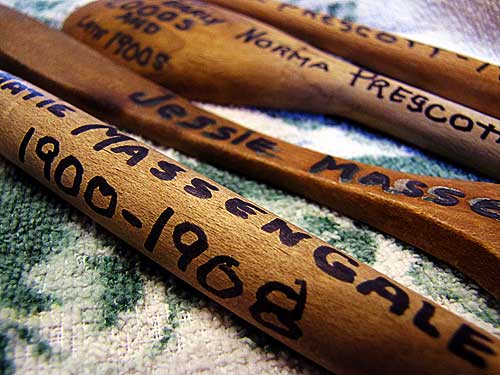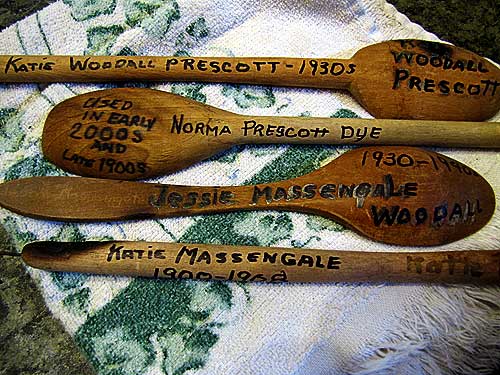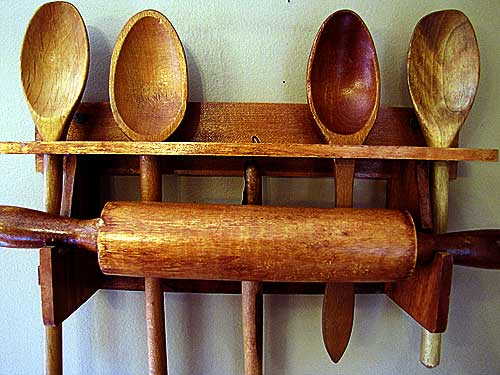These are a few of my favorite things.

There are five wooden spoons in this set given to me by my mother. They hang on a wall rack with a rolling pin. This spoon rack hung in my mother’s kitchen as long as I can remember. Four of the spoons have writing on the back to say whose spoon was whose, and dates when the spoons were known to be used by them.

Norma Prescott Dye–my mother. Katie Woodall Prescott–my grandmother. Jessie Massengale Woodall–my great-grandmother. Katie Massengale–my great-great-grandmother.

The fifth spoon in the set has no writing on the back and I’m not sure if it was anything special or just another one of my mother’s.
I don’t use these particular wooden spoons–they’re old, and among my most prized possessions. But I do love and use wooden spoons. Do you?
Wooden spoons are simple items, so their easy-to-carve yet extremely useful nature means they appear far back in history all over the planet. In America, we tend to think of them as something that reminds us of our grandmothers–yet they are still imminently practical today, so set aside your stainless steel and silicone for a moment and consider all the ways a wooden spoon is better and why you should use one!
1. It doesn’t heat up as quickly as other materials, which means you don’t need a plastic safety handle or an oven mitt to use them over a hot pot.
2. It doesn’t chemically react with acidic ingredients–or melt or leach strange chemicals into food as plastic utensils can.
3. It won’t scratch pots and pans and bowls–it’s especially perfect for removing air bubbles in glass canning jars so you don’t risk scratching the glass.
4. It’s perfect as a spatula replacement for folding batters. (The well of a wooden spoon is usually pretty shallow.)
5. It’s pretty, lends a vintage quality to your kitchen counter even if it’s brand new.
What about contamination? Wood is a porous surface, this is true. Spoons used in mixtures containing raw meat can be sanitized in a dishwasher, or with a strong sanitizing cleaning product in your kitchen sink. Is it okay to put wooden spoons in the dishwasher? It would be better not to, but if dishwasher high heat sanitizing is the only thing standing between you and your wooden spoons, do it. I wouldn’t put my genuine vintage 100-year-old wooden spoons in a dishwasher (NO!), but new good-quality spoons will stand up to it–just be sure to properly oil them afterwards because repeat washing, especially with high heat or strong sanitizing, will eventually dry your spoons out, causing them to crack and degrade before their time.
Need a good spoon oil recipe? I’ve got one!
Spoon Oil:
16 ounces mineral oil
4 ounces beeswax, cut in chunks
Warm the mineral oil by placing the container in a pot of warm water. Place beeswax in a wide-mouth jar and melt in a double boiler. Remove from heat and slowly pour the mineral oil into the melted beeswax.
I keep my spoon oil in a quart jar. It solidifies when cool, so you have to heat it up for each use. I use a simple makeshift double boiler using a small pot with some canning rings inside to hold the jar.

Once it’s melted, place the jar (still in the pot to keep it warm) on a towel or pot holder near where you will be using it. To use, just stick the spoon in there, one end at a time, remove and rub with a cloth or paper towel, smoothing the oil up the wood where you can’t reach when you stick it in there. Rub it in well. It makes a huge difference.
If you have something you can’t dip into the spoon oil because it won’t fit in the jar, you can spoon some out onto your cloth and rub it in a little at a time to whatever you are restoring. Spoon oil starts solidifying quickly once removed from the warm jar, but it is soft enough to rub in. (If there is some writing, such as on my spoons, be sure you do a test area first. I have no trouble with it making the ink run in the writing on my spoons.)

See how good that looks? Spoon oil isn’t just for wooden spoons on display, though. Use it on your regular kitchen daily-use wooden spoons. Who knows who may want to jot your name down on the back of them and hang them on the wall in 100 years. Keep them in good shape!





